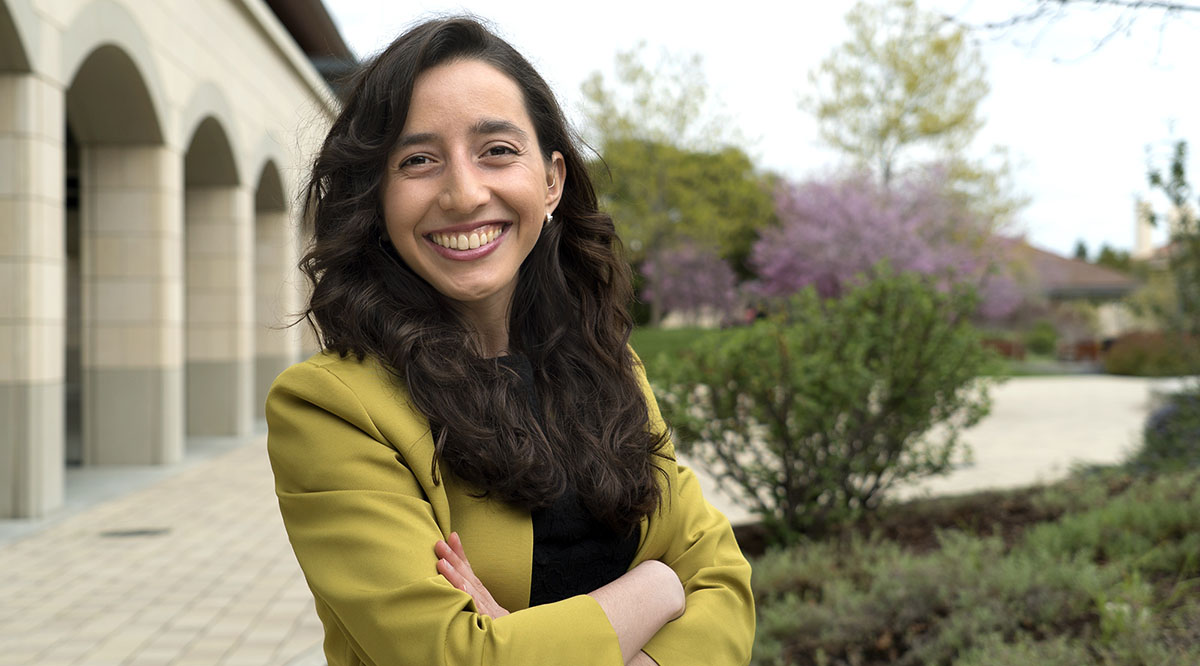 Courtesy: Zina Jawadi
Courtesy: Zina Jawadi
One day last spring, during a clinical experience at Ronald Reagan UCLA Medical Center in Los Angeles, my attending physician and I entered the hospital room of a patient with a cardiopulmonary condition. As the visit proceeded, it became clear that the patient could not hear most of what we discussed. The patient, who was visibly distressed, asked the doctor to repeat himself multiple times. Our face masks and shields prevented the patient from seeing our facial expressions and lips, and the machines that monitor vital signs overpowered the volume of our voices. I noticed a microphone with a headset on the patient’s lap and, with permission, picked it up and started using it, which greatly improved both the quality of the visit and the patient’s comfort.
Having grown up with hearing loss and having befriended hundreds of people with hearing loss through the Hearing Loss Association of America, the patient’s listening difficulties and fatigue were all too familiar to me. With widespread use of masks, which muffle voices and cover faces, the COVID-19 pandemic has made communication more challenging for everyone. But it has disproportionally affected people like me with hearing loss — exacerbating communication barriers that we already faced.
Communication barriers during the pandemic
About 48 million Americans and 466 million people worldwide have hearing loss — a figure expected to rise to 900 million by 2050, due in part to such practices as listening to music at loud volumes, according to the World Health Organization. Yet, due to stigma and high cost, hearing aid usage remains low — and, in some developing countries, virtually nonexistent.
Masks degrade the quality and volume of speech. Speaking louder does not help the listener — it merely amplifies the muffled words without improving their clarity. Social distancing and masks undermine the interpretation of facial expressions and body language. Visual cues — and the crucial ability to read lips — can enhance speech recognition by up to 12 decibels. That is the difference between conversational speech in a quiet room and one with a noisy vacuum cleaner. Almost everyone unconsciously uses and benefits from speech reading, but the difference is immense for people with hearing loss. Facial expressions are also an integral part of sign language, which is a crucial component of Deaf culture.
Online communication platforms and videos — which many of us relied on during the pandemic — have a wide range of audio and captioning quality. Early in the pandemic, one of the most used platforms, Zoom, did not offer automatic captions. The company finally added that feature — but initially only in the paid platform. Pioneering work by hearing rights advocates like Shari Eberts, MBA, finally convinced the company to offer free automatic captioning to all. Yet, despite all this advocacy, activation of automatic captions in Zoom meetings remains an issue. Even with captioning, the extra mental effort required by those with hearing loss to listen to and participate in virtual conversations on video can quickly lead to listening fatigue — or the recently more popularized term, “Zoom fatigue.” The hearing loss community experienced exhaustion with in-person conversations long before the pandemic, but social distancing efforts only exacerbated the challenges.
A study conducted by the Hearing Loss Association of America and Cochlear, one of the three main cochlear implant medical device companies, found that 95% of people with hearing loss cited masks as obstacles to communication during the pandemic. Approximately 50% experienced higher levels of anxiety, isolation, and loneliness and found it more difficult to connect with friends and family.
My experiences as a medical student with hearing loss
On a personal note, I began medical school during the pandemic and was learning the new medical language in a masked world. The first year of school required me to navigate a wide range of acoustical environments: in-person labs with social distancing, face masks and shields, recorded slides/audio-only lectures without video, and live Zoom lectures. In addition to my hearing aids, I use a Bluetooth microphone/FM system, iOS’ accessibility features, clear face masks, a digital amplified stethoscope, a computer sound amplifier, real-time captioning for lectures, and automatic captioning. These technologies have been transformational. For example, the computer sound amplifier gives me full control over the quality and loudness of the audio, and music has never sounded more beautiful (yes, many people with hearing loss listen to music!).
At the same time, finding and managing the right technologies consumes extensive time and energy and is often exhausting and logistically challenging. For instance, my Bluetooth microphone is highly sensitive, and any slight movement — like someone’s medical badge rubbing against their white coat — is too loud and sometimes even painful to my ears. Most people do not realize how significant my hearing loss is or that I even have a disability; as a result, they often become confused when I hand them a microphone. If I want an instructor to wear the microphone, I need to plan my schedule accordingly so that I can arrive before class begins to hand the microphone to the instructor and explain how to wear it. Passing around the microphone — for example, between students in a lab setting — can be cumbersome when I am in scrubs. Unfortunately, all of my devices fail me during group conversations in noisy environments. Nevertheless, I cannot imagine my life without these amazing technologies and am so grateful to have access to them. They empower me to take control over my hearing and access to education in a world designed for people without hearing loss.
Hearing loss communication tips for health care providers
With the right accommodations and support, people with hearing loss can thrive. Seemingly small changes in communication can be transformational for a person with hearing loss. Yet, based on personal experience and conversations with others in the hearing loss community, many physicians do not ask patients if they need accommodations for hearing loss, even when the patient’s hearing loss is on record. I speculate that physicians do not ask because most medical schools provide little to no training on disability and accommodations and because they do not realize how much hearing health impacts the quality of and access to medical care.
The following tips can help health care providers improve communication with patients with hearing loss.
Prior to the visit:
- Standardize accommodation requests and arrange for accommodations before the patient arrives at the clinic (e.g., include a question about accommodations in a pre-visit questionnaire).
- Make waiting rooms more hearing accessible — implement a schedule numbering system that flashes on the TV or enable automatic texts to notify patients.
- Have live chat to obtain support instead of telephones.
During the visit:
- At the start of every visit (regardless of whether a disability is on record), ask if the patient needs any accommodations.
- Face the patient. Speak slowly. Speaking louder does not help those with hearing loss, as it does not improve clarity of sound. Provide visual aids. Make topic transitions visual and clear.
- Avoid noises like typing on the computer, flipping papers, and walking around the room.
- Enable lip reading by avoiding covering your face with your hands, taking off the mask when feasible or using a clear face mask, and facing the patient. Federal and state mask mandates have exemptions for those speaking to someone with hearing loss, including in the health care setting (e.g., Centers for Disease Control and Prevention, Federal Register).
- Context is crucial for being able to follow conversations. Point to words, especially if using medical jargon.
- Repeat when asked, ideally paraphrasing what you said. Some words, sounds, and frequencies are easier to hear than others.
- Ask patients to reiterate what they understand — they may not realize they did not hear something important.
- Accommodate people based on what they say they need. If a patient’s hearing loss is in the medical record, practice these communication tips even if accommodations are not requested.
- Ask patients how hearing loss has impacted their health. At the same time, do not assume that a patient’s chief complaint is related to a disability.
- Connect the patient with local resources and support groups.
- Encourage people to seek treatment for their hearing loss. Evaluate the patient for potential comorbidities like depression and social isolation.
- Life transitions can be challenging; provide resources if feasible (e.g., an excellent audiologist in the area).
Special considerations for telehealth visits:
- Ensure that the platform offers captions. Activate captions.
- Avoid having light behind you, since it makes it harder to read lips and facial expressions.
- Ensure that your room is quiet and has excellent Wi-Fi. Wear a headset with a microphone.
- Write down the key points. Utilize the chat function, especially for words that may not be familiar to the patient.
As I navigate the world of medicine as a medical student, I am constantly reminded of the importance of clear, precise communication between patient and provider and between members of a care team. I urge you to actively consider hearing loss and communication in health care. Accommodating people with hearing loss is not only the morally right thing to do but is also essential in establishing trust, formulating a diagnosis, creating an effective treatment plan, and ensuring that patients play an active role in their health. In some cases, that difference can literally be life or death.
